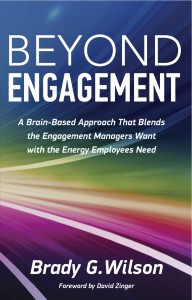More and more, the business world is seeing a troubling trend: workplaces full of employees and managers who are engaged, but not energized.
Organizations may have committed and loyal workers—but those workers are also exhausted.
In fact, it appears that the more leaders try to manage engagement, the more disengaged, depleted and cynical their employees become.
So what is causing this?
Simply put, engagement strategies are not factoring in one very critical thing: the importance of the human brain.
It’s not rocket science; it’s brain science
Let’s not understate things: the brain is a powerful organ.
The brain is the control centre of how we think, feel, behave, and perceive and understand the world around us. It is capable of astonishing levels of value creation. It is also one of the most fuel-hungry organs in the human body.
What does this mean? Science shows that the body’s use of fuel is judicious. It considers safety a necessity, and self-actualization a luxury. As such, when the body’s energy tank runs low, the brain prioritizes the use of fuel: giving first dibs to things like autonomic responses (blinking and breathing), immune and digestive systems, balance and locomotion, and flight/fight safety features.
Low on energy, what loses out first is the executive function: the part of the brain that allows us to focus, regulate emotions, prioritize, plan, make decisions and take action.
Without energy, our base-level thinking continues to function, but the mind’s power tools fail to operate: those tools that enable us to think strategically, collaborate broadly, communicate clearly, and execute decisively.
How this shows up at work
So what does a low-energy workforce look like on an individual level?
Here is an example: a manager or employee is driving to work, thinking “I need to have that tough conversation with Ellen.” However, resolving conflict requires the ability to communicate clearly, enabled by the executive function. If that person already feels run down and low on energy, they may put the task off until the next day—even indefinitely. Instead, they may check their email, watch a YouTube video, organize their office, or drop in on a colleague—anything but one of those value-adding activities that requires so much of one’s energy.
Moreover, on an organizational level, knowledge workers without well-fuelled brains are unable to think innovatively about how to get to root causes and fix systemic issues. Lacking energy, they resort to quick fixes, workarounds, and reactive firefighting, thereby hardwiring ongoing depletion into the system.
Why this matters
In today’s competitive marketplace, effort without innovation—even from the most engaged and loyal of employees—just won’t cut it.
Many of today’s leaders certainly have good intentions where their employees’ engagement levels are concerned. But typical engagement initiatives focus on unlocking discretionary effort: that is, getting people to go above and beyond the call of duty.
That is virtually impossible without appealing to the human brain—the centre of all our experiences. When employees are engaged but lack passion, resilience and excitement, all leaders get in return is dedicated under-performers: people unable to put their best work forward.
Manage energy, not engagement
To create a sustainable, innovative and high-performing organizational culture, businesses need to focus on both engagement and energy—essentially, moving “beyond engagement” as we know it today.
That requires looking to brain science, understanding how the mind works, and finding ways to safeguard people’s executive function.
Science shows that one way to make the shift from managing engagement to managing energy is through conversation. In fact, meaningful, face-to-face conversation that demonstrates value, respect and care is a much more effective way to boost employee performance than surveys, town halls, newsletters and departmental action plans.
Not only does conversation release high-performance hormones that promote trust and deepen the leader-employee relationship; conversation can also address identify and address negative beliefs, creating a much greater sense of agency in others.
Short, simple and frequent “Energy Check” conversations are a proven way leaders can unlock insight and possibility in employees’ brains. It can be as simple as asking employees what is energizing them at the moment, and what is depleting their energy. This fuels a great customer experience and sustainable business results.
By shifting to an organizational culture that honours how the human brain works, entire organizations can transform themselves into sustainable hubs of passionate, innovative and enthusiastic employees—essentially, the definition of a truly engaged, energized workforce.




